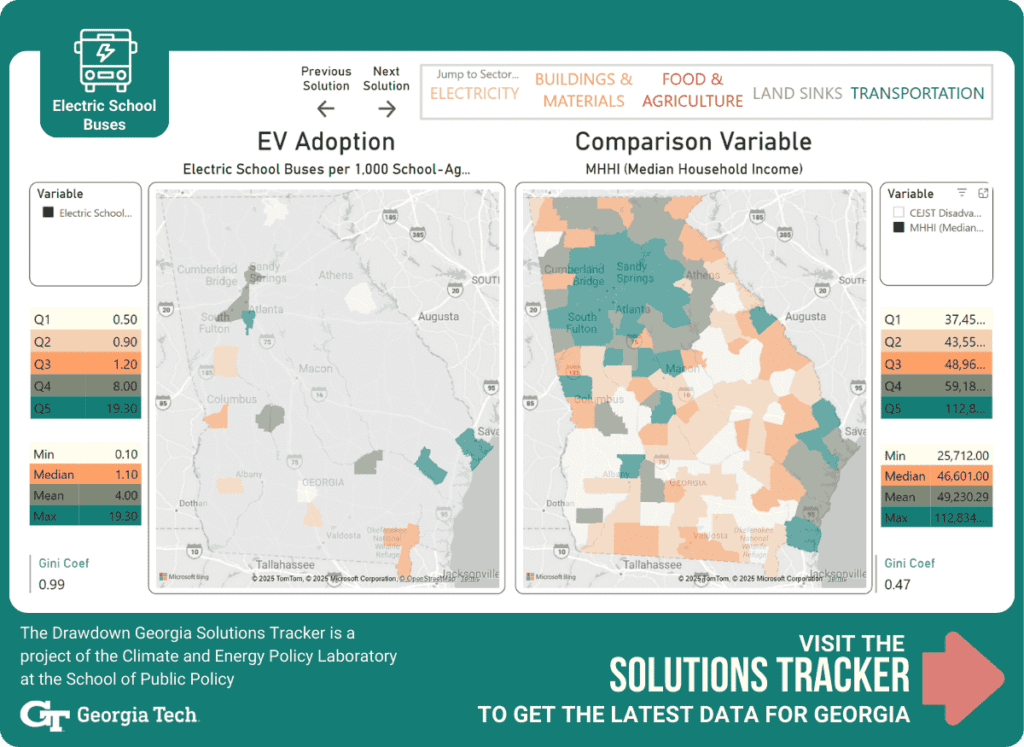The Benefits of Energy-Efficient + Electric Trucks
U.S. trucks consume about 50 billion gallons of diesel fuel each year, a disproportionate quantity relative to the distance traveled. Increasing fuel efficiency for both new and existing trucks can lead to significant reductions in greenhouse gas emissions. Numerous fuel-saving technologies are available at compelling paybacks.
Access Energy-Efficient Truck Resources from Drawdown Georgia
Market Readiness and Available Technology
Fuel-efficient medium-duty (MD) and heavy-duty (HD) trucks are available and already have a strong presence in the market. Vehicle technologies and improved connectivity and routing can contribute to reductions within this solution category. Because of the compelling economics and prevalence of a range of truck applications within the economy, market forces encourage technological innovation.
Energy-Efficient Trucks as a Climate Solution in Georgia
The Drawdown Georgia research team estimates that Georgia could reduce emissions by one megaton (Mt) of CO2e by reducing diesel fuel use in medium and heavy-duty trucks by 10%.
What is the Carbon Emissions Reduction Potential by 2030?
Achievable reduction potential is derived by taking the technical reduction potential, outlined below, and developing a more realistic forecast that takes current rates of deployment, market constraints, and other barriers into consideration.
For energy-efficient trucks, the Drawdown Georgia research team has calculated the achievable reduction potential to be 2.29 Mt of CO2e.
What Is the Upper Limit of Carbon Emissions Reduction Potential?
Technical reduction potential reflects the upper limit of emissions reductions for this solution without regard to the constraints that exist in the real world, such as economic or political considerations.
For energy-efficient trucks, the Drawdown Georgia research team has calculated the technical reduction potential to be 4.2 Mt.
Progress on Energy-Efficient Trucks in Georgia
The Fleet Fuel Study conducted by the North American Council for Freight Efficiency suggests that the average fleet-wide fuel economy of trucks has increased from 6.91 mpg in 2017 to 7.76 mpg in 2023.
Two technologies have seen significant growth in adoption: high-efficiency alternators rose from 29% to 50% in adoption, and predictive cruise control rose from 50% to 97%. However, some other technologies and practices also saw a decrease in usage (e.g., smart air-dryer/compressor).
NHTSA announced new CAFE standards in 2024 that require an increase in heavy-duty pickup truck and van fuel efficiency by 10% per year for model years 2030-2032 and 8% per year for model years 2033-2035. This will result in a fleetwide average of approximately 35 miles per gallon by model year 2035.
For model years 2027 to 2032, the EPA published GHG standards for heavy-duty vocational trucks and cab tractors (HDVs). Based on a potential compliance pathway published by EPA in its regulatory impact analysis, 60% of new light heavy-duty, 32% of medium-heavy duty, 18% of new heavy-duty vocational trucks, and 55% of new day and sleeper cab tractors would be plug-in hybrid. EPA also shows an equivalent compliance pathway that can be met by the adoption of 10-24% green hydrogen HDVs instead of PHEVs in the new fleet.

Fort Benning in Chattahoochee County and Fort Stewart in Long County (both army bases) show notable adoption of electric buses. Fulton County, which includes most of Atlanta and is the largest school system in Georgia, also shows significant adoption.
How Reliable Is Our Estimate For This Drawdown Georgia Climate Solution?
Logistics account for 7% of the state's gross state product (GSP), employing nearly 240,000 Georgians and generating over $83.4 billion in sales annually. The National Highway Traffic Safety Administration (NHTSA) and the EPA periodically publish information on fuel efficiency and emissions for MD and HD vehicles, as well as draft regulatory policy-setting efficiency and emission standards.
Improving freight movement efficiency and reducing congestion, particularly in bottleneck congestion sites, will yield significant fuel savings and carbon emissions reductions.
Significant opportunities exist in converting MD vehicles to alternative fuels such as compressed natural gas (CNG) and hybrid-electric powertrains, which show carbon emissions reductions in excess of 20%.
Additional opportunities exist to substitute MD diesel trucks with electric or hybrid-electric vehicles, as many are centrally garaged, rarely require operation outside of a defined area, and have routes (i.e., predictable, start-stop, urban) that can exploit the greenhouse gas-reducing benefits of hybridized or electrified powertrains.
Cost Competitiveness
Fuel-efficient vehicles can incur higher upfront costs, but paybacks can be attractive. MD applications may exploit technologies that have been developed for light-duty vehicles (LDVs) and are now competitive at scale for selected use cases. Relative to the price tag of other carbon emissions reduction solutions, the cost is relatively minimal, and fuel-saving technologies in freight result in concurrent economic benefits and greenhouse gas emissions reductions.
Beyond Carbon Attributes
The solution offers benefits to the environment and public health from improvements in air quality. Other benefits include the creation of jobs in the manufacturing and engineering of fuel-efficient trucks. One study estimated that widespread national deployment of more-efficient trucks would create 63,000 additional jobs by 2020 and 124,000 jobs by 2030. Additionally, truck drivers and owners benefit from the cost savings of improved fuel efficiency.
There can be higher initial upfront investments, early depreciation, and sunk costs associated with incumbent assets, and other market barriers for adoption.



